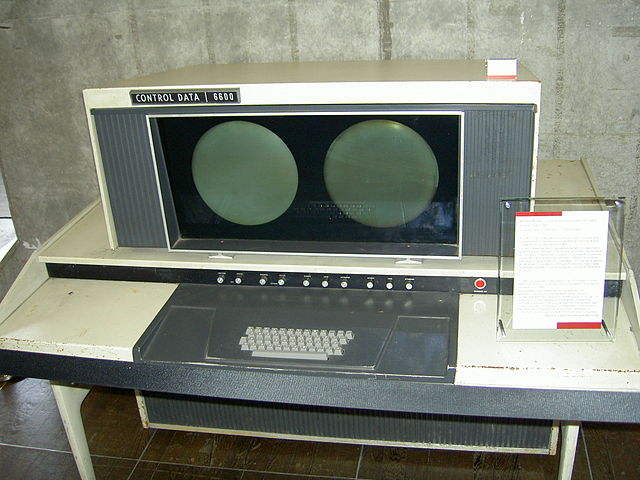The CDC 6000 series is a discontinued family of mainframe computers manufactured by Control Data Corporation in the 1960s. It consisted of the CDC 6200, CDC 6300, CDC 6400, CDC 6500, CDC 6600 and CDC 6700 computers, which were all extremely rapid and efficient for their time. Each is a large, solid-state, general-purpose, digital computer that performs scientific and business data processing as well as multiprogramming, multiprocessing, Remote Job Entry, time-sharing, and data management tasks under the control of the operating system called SCOPE. By 1970 there also was a time-sharing oriented operating system named KRONOS. They were part of the first generation of supercomputers. The 6600 was the flagship of Control Data's 6000 series.
Open panels of the CDC 6500 undergoing restoration at Living Computers: Museum + Labs in Seattle.
CDC 6600 computer. Display console shown in the foreground, main system cabinet in background, with memory/logic/wiring to the left and middle, and power/cooling generation and control to the right.
Console for CDC 6600
Operator console of the CDC 6400 with four magnetic tape memory units in the background with a magnetic tape controller unit in front of them at the Rechenzentrum (Computer Center) of RWTH Aachen University, Germany (1970).
Control Data Corporation (CDC) was a mainframe and supercomputer company that in the 1960s was one of the nine major U.S. computer companies, which group included IBM, the Burroughs Corporation, and the Digital Equipment Corporation (DEC), the NCR Corporation (NCR), General Electric, and Honeywell, RCA and UNIVAC. For most of the 1960s, the strength of CDC was the work of the electrical engineer Seymour Cray who developed a series of fast computers, then considered the fastest computing machines in the world; in the 1970s, Cray left the Control Data Corporation and founded Cray Research (CRI) to design and make supercomputers. In 1988, after much financial loss, the Control Data Corporation began withdrawing from making computers and sold the affiliated companies of CDC; in 1992, Cray established Control Data Systems, Inc. The remaining affiliate companies of CDC currently do business as the software company Ceridian.

The 12-bit CDC 160 and 160-A architecture were the basis of the peripheral processors (PPs) in the CDC 6000 series.
CDC 6500 with open panels. On display at the Living Computer Museum in Seattle, Washington.
CDC 6600
CDC 7600, serial no. 1






